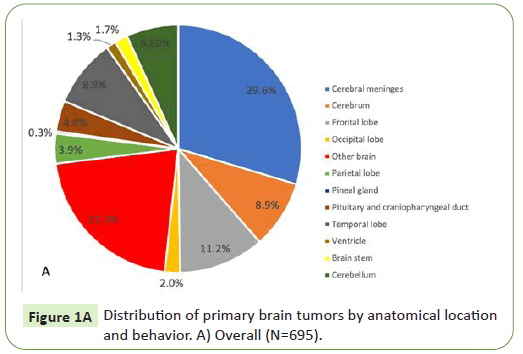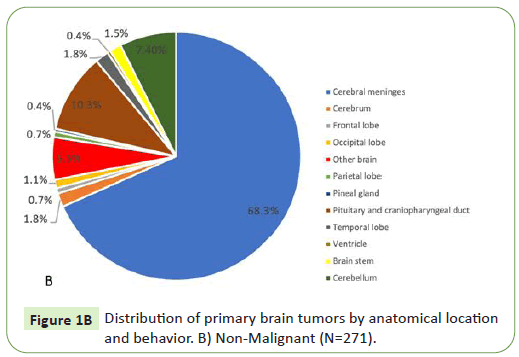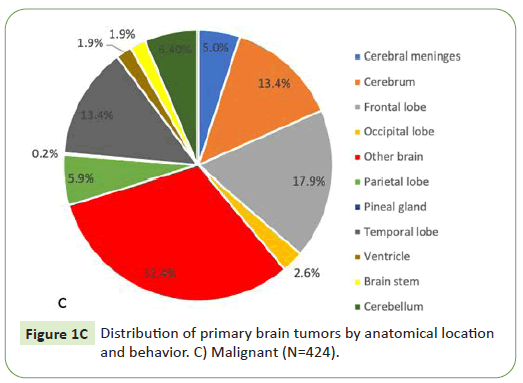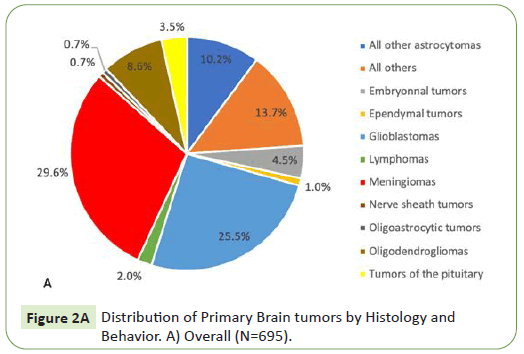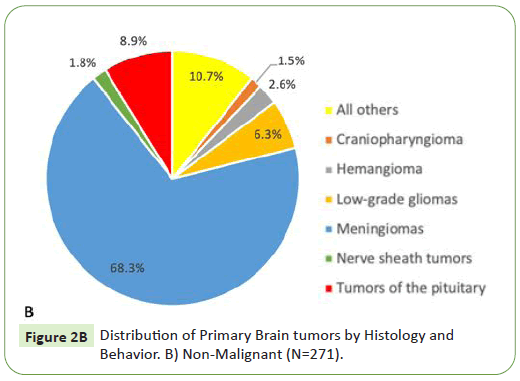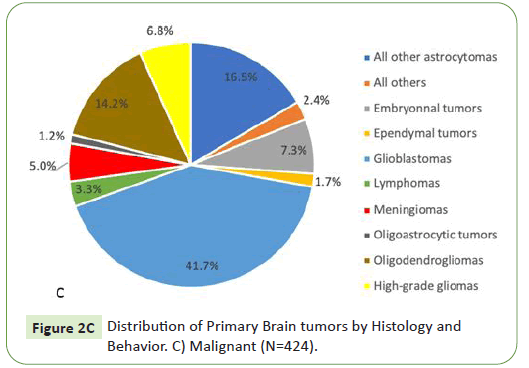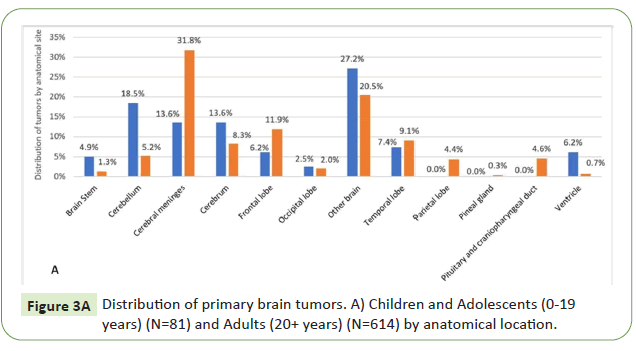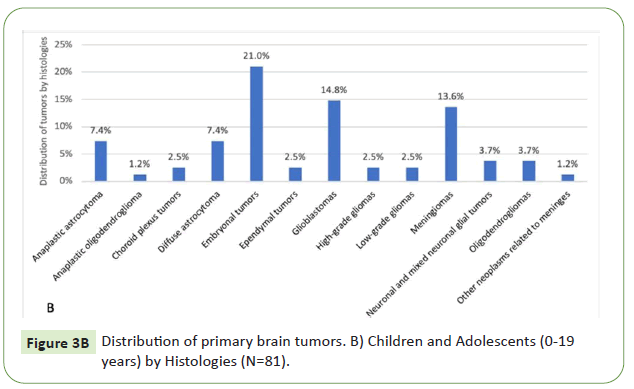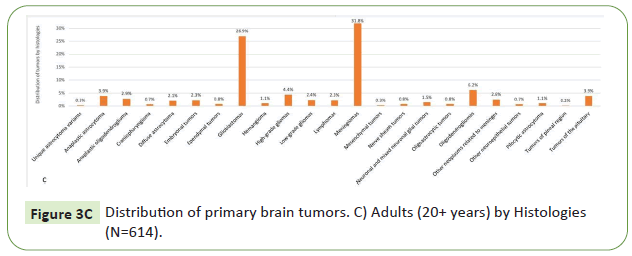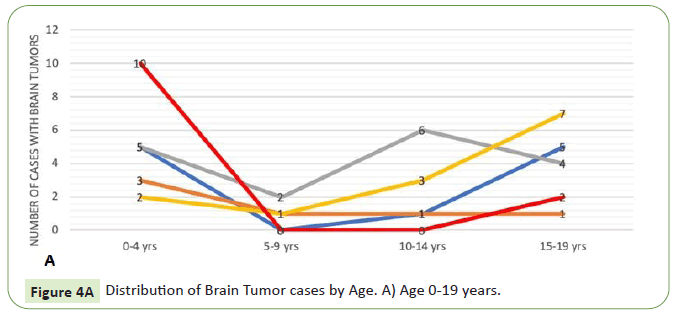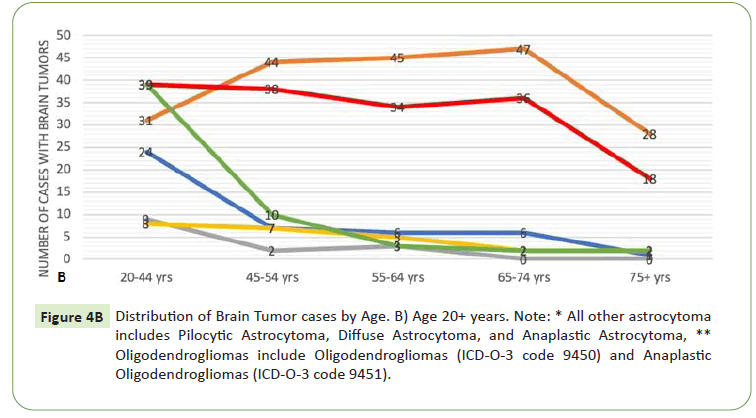Keywords
Brain neoplasms; Epidemiology; Meningioma; Glioblastoma
Introduction
According to the World Cancer Research Fund, the brain and
other central nervous system (CNS) tumors are ranked the 17th
most common cancer in the world and account for 1.7% of all
cancer, excluding non-melanoma skin cancer [1]. He reported
a 17.3% [2] increase in central nervous system cancer between
1990 and 2016. Along with this surge in incident cases and
despite their rarity, CNS tumors represent a disproportionally
high source of morbidity and mortality worldwide [3]. These
tumors cause a high burden on societies and health care systems
because of their substantial malignant potential and the cost of
the complex treatment required, ranging from chemotherapy, radiation therapy, and neurosurgery. However, the incidence
varies significantly between studies, due probably to the lack of
a standardized approach to quantify the results [4]. Brain tumors
are the most common solid tumors in the paediatric population.
Compared to adults, paediatric brain tumors have different
histological distribution and are most located in the infratentorial
location [5,6].
Brain tumors encompass more than 100 different histologies,
classified into more than 20 major histological groups [7,8]. To
date, causes of brain tumors remain unclear with only a small
proportion caused by radiation, immunosuppression leading
to brain lymphomas, and hereditary genetic syndromes as in
neurofibromatosis, Li-Fraumeni syndrome, and Turcot syndrome [9]. Also, there is a predilection for some brain tumor subtypes
with certain risk factors. For instance, meningioma is tightly
associated with previous radiation exposure and is more common
among females [9].
In the Middle East region, few types of research have addressed
the issue of brain tumors. Most papers describing the
epidemiology of these tumors were from Saudi Arabia, Egypt,
and Kuwait [10-15]. For instance, a study in Western Saudi Arabia
found that the most common brain tumor was astrocytoma and
that their results were like international ranges [12]. Another
study conducted in Egypt showed that gliomas followed by
meningiomas were the most common histologies [15]. Moreover,
in Lebanon, a small country in the Middle Eastern region with
a population of nearly 6.8 million people, 238 cases of brain
cancers were reported in 2016 by the Ministry of Public Health
(MOPH). To date, no study has been conducted to describe the
epidemiology of the different types of brain tumors among its
population. This paper outlines the distribution of these tumors,
in four Lebanese medical centers, concerning age, sex, behaviour,
histology, and anatomical location. Our objective is to show the
most common histologies in our sample and provide a detailed
report of the different malignant and non-malignant tumors. We
also compare our results with available data from other countries
in the region and worldwide.
Materials and Methods
Study design
This is an epidemiological descriptive retrospective study, in
which data were collected from pathology reports of 695 patients
diagnosed with primary brain tumors in the period between
January 2007 and July 2017. Secondary (metastatic) brain tumors
that rose primarily in a site outside of the CNS, and tumors arising
from the spinal cord were excluded from this study. Data were
retrieved from four medical centers across Lebanon: Sahel General
Hospital (SGH), Al Zahraa Hospital University Medical Center
(ZHUMC), National Institute of Pathology (INP), and Hammoud
Hospital University Medical Center (HHUMC). INP is a referral
center of pathology for more than 30 centers and hospitals across
Lebanon, including Abou Jaoude Hospital, Bekaa Hospital, Ain
Wazein hospital, and others [16]. Most of the patients, 70.36%
(489 patients) were from INP, 5.18% (36 patients) were from SGH,
11.08% (77 patients) from ZHUMC and 13.38% (93 patients) from
HHUMC. This study was approved by the Institutional Review
Boards (IRB) of all four previously mentioned hospitals, as well as
the Lebanese University’s IRB.
Variable coding
The collected variables were sex, age at diagnosis, histopathological
type of the tumor, anatomical location (frontal lobe, occipital
lobe, temporal, meninges, etc.) and behavior (malignant vs. nonmalignant).
Histology, behavior, and anatomical location were
coded according to the International Classification of Diseases
of Oncology, third edition (ICD-O-3) manual, and in line with the
manual’s coding guidelines for both topography and morphology,
as well as 2007 WHO Classification for the CNS, which was used
especially for behavior coding [7,8].
Moreover, [8] used a grouping of sites that is based on the WHO
ICD-O-3 classification of oncology [7,8]. This grouping has been
used in this report to classify anatomical sites and histologies of
these tumors. The topographical areas and assigned codes that
were used in this report can be found in Supplementary Table
1. All histologies and assigned ICD-O-3 histology codes and
behaviors reported in this study are shown in Supplementary
Table 2.
Although pilocytic astrocytoma is coded as non-malignant by
WHO code, it is considered malignant in population-based cancer
registries in the United States Department of Health and Human,
[8]. Therefore, to have comparable data, we coded pilocytic
astrocytoma as malignant in Supplementary Table 2. Besides,
some tumors in our report were labelled “low-grade gliomas”
and were coded as 9380/1, translated as gliomas with uncertain
malignant or benign behavior [7].
Statistical analysis
Descriptive statistics were conducted using SPSS 23.0 statistical
analysis software (SPSS, Inc., Chicago, IL, USA). Duplicates
between centers were checked and subsequently removed. Basic
descriptive analysis is conducted for categorical and continuous
variables (bar graphs, pie charts and scatter plots). Chi-square
tests were used for categorical variables and a chi-square for
homogeneity test was used for testing whether the proportions
of variable categories are equal.
Results
Overview
In Supplementary Table 3 depicts in detail the different
histologies found in our dataset, as well as the different sex,
behavior, and age groups. Over 40 different histologies were
found in our sample. Interestingly, 61% of the tumors were of
malignant behavior, while only 39% were non-malignant. Tumors
ranged from common tumors such as meningiomas (29.6%) to
rare histologies such as dysembryoplastic neuroepithelial tumor
(0.1%), atypical teratoid rhabdoid tumor (0.1%), and solitary
fibrous tumor (0.1%).
Anatomical location
In Figure 1 shows the distribution of brain tumors by anatomical
location. Overall, the most common locations were the cerebral
meninges (29.6%), other brain category, which encompasses
overlapping regions in the brain and unspecified brain locations
(21.3%), and the frontal lobe (11.2%). Only 1.3% of brain tumors
were found in the ventricles and 1.7% in the brainstem shown in Figure 1A.
Figure 1A: Distribution of primary brain tumors by anatomical location
and behavior. A) Overall (N=695).
Among non-malignant brain tumors, the most common location
was cerebral meninges with a frequency of 68.3% followed by
the pituitary and craniopharyngeal duct (10.3%) and cerebellum
(7.4%) in Figure 1B. Among malignant cases, our results showed
that other brain category was the most common location (31.4%),
followed by the frontal lobe (17.9%) and temporal lobe (13.4%)
in Figure 1C.
Figure 1B: Distribution of primary brain tumors by anatomical location
and behavior. B) Non-Malignant (N=271).
Figure 1C: Distribution of primary brain tumors by anatomical location
and behavior. C) Malignant (N=424).
Histologies in our sample were organized using the CBTRUS
groups, as mentioned earlier. Figure 2 represents the distribution
of brain tumor histologies. Overall, meningiomas were the
most common histology in our sample with 206 cases (29.6%).
Glioblastomas were the second most common histology with 177
cases (25.5%). Nerve sheath tumors and ependymal tumors were
rare accounting for only 0.7% and 1% of the total number of cases, respectively in Figure 2A. Among malignant cases, glioblastomas
were most found (41.7%), followed by all other astrocytomas
(16.5%), oligodendrogliomas (14.2%), and embryonal tumors
(7.3%) (Figure 2B). Among non-malignant, meningiomas were
the most common histology with a frequency of 68.3% while
tumors of the pituitary, craniopharyngioma, and haemangioma
accounted for 8.9%, 1.5%, and 2.6%, respectively in Figure 2C.
Figure 2A: Distribution of Primary Brain tumors by Histology and
Behavior. A) Overall (N=695).
Figure 2B: Distribution of Primary Brain tumors by Histology and
Behavior. B) Non-Malignant (N=271).
Figure 2C: Distribution of Primary Brain tumors by Histology and
Behavior. C) Malignant (N=424).
Sex distribution
To analyze the distribution of sex, male to female ratio was
calculated and the chi-square test for homogeneity was used,
to determine whether the proportions of males and females are
equal. Except for non-malignant meningiomas, chi-square tests
revealed that males and females had an equal distribution of
brain tumors (p>0.05). Non-malignant meningiomas were 2.6
times more common among women than men (male-to-female
ratio=0.38, p<0.001).
Distribution by age groups
The mean age of diagnosis of brain tumors is 47.43 years
(SD=21.20). In Supplementary Table 3 details the distribution of
tumors according to three age groups (0-14 years, 15-39 years,
and 40+ years). However, to simplify the analysis, we used two
main age groups (0-19 years for children and adolescents and 20+
years for adults) in subsequent pie charts and plots in Figures 3
and 4.
Our results showed that brain tumors were significantly higher
in adults than in children and adolescents (88.34%, 614 cases,
vs. 11.65%, 81 cases; p<0.001). Also, the ratio of malignant-to Our results showed that brain tumors were significantly higher
in adults than in children and adolescents (88.34%, 614 cases,
vs. 11.65%, 81 cases; p<0.001). Also, the ratio of malignant-tonon-
malignant cases in children and adolescents was significantly
higher compared to adults (4.06 vs. 1.41, p<0.001). As a result,
children and adolescents have a higher risk of being diagnosed
with malignant brain tumors compared to adults.
In Figure 3 shows the distribution of brain tumors by site and
histology in each age group. The most common location of brain
tumors in children and adolescents is other brain (27.2%) while in
adults, cerebral meninges are the most common location (31.8%).
Tumors in the cerebellum and brain stem were more prevalent
in children and adolescents (18.5% and 4.9%, respectively), in
comparison to adults (5.2% and 1.3%, respectively) in Figure
3A. Embryonal tumors such as medulloblastoma were the most
common reported histologies (21.0%) in children and adolescents,
followed by pilocytic astrocytoma (16.0%) and interestingly by
glioblastomas (14.8%) and meningiomas (13.6%) in Figure 3B. In
contrast, the most common tumors in adults were meningiomas
(31.8%), glioblastomas (26.9%), and oligodendrogliomas (6.2%).
On the other hand, in adults, miscellaneous tumors such as
pilocytic astrocytoma, ependymal tumors, nerve sheath tumors,
and craniopharyngioma were found at rates close to 1% in Figure
3C.
Figure 3A: Distribution of primary brain tumors. A) Children and Adolescents (0-19
years) (N=81) and Adults (20+ years) (N=614) by anatomical location.
Figure 3B: Distribution of primary brain tumors. B) Children and Adolescents (0-19
years) by Histologies (N=81).
Figure 3C: Distribution of primary brain tumors. C) Adults (20+ years) by Histologies
(N=614).
A more robust analysis of selected tumors, as shown in Figure
4, shows their distribution across multiple fine-grained age
groups. Surprisingly, 10 cases of glioblastomas and 5 cases of
meningiomas were diagnosed between 0-4 years (specifically
at age 0), then abruptly decreasing till age 10-14 years. These
tumors tend to resurge and stabilize between 45 to 74 years with
a peak of 47 cases in the 65-74 age groups. Furthermore, pilocytic
astrocytoma reached a peak of 7 cases at 15-19 years in children
and adolescents. The most conspicuous observation in children
and adolescents is that most tumors diagnosed in ages 5-9 years had the lowest number of cases, compared to other age groups.
However, in adults, a high number of cases of oligodendrogliomas
(39 cases) and all other astrocytoma’s (24 cases) were found in
younger adults (20-44 years). Tumors of the pituitary were found
in stable numbers, with approximately 7 cases per class of age,
between ages 20 till 64 years of age in Figure 4A. Besides, the
highest number of cases of embryonal tumors was reported in
the 20-44 age group (9 cases), followed by 7 cases in the 15-19
age group in Figures 4A and 4B.
Figure 4A: Distribution of Brain Tumor cases by Age. A) Age 0-19 years.
Figure 4B: Distribution of Brain Tumor cases by Age. B) Age 20+ years. Note: * All other astrocytoma
includes Pilocytic Astrocytoma, Diffuse Astrocytoma, and Anaplastic Astrocytoma, **
Oligodendrogliomas include Oligodendrogliomas (ICD-O-3 code 9450) and Anaplastic
Oligodendrogliomas (ICD-O-3 code 9451).
Discussion
Strikingly, in the CBTRUS database, only 30.9% of cases were
malignant and 69.1% were non-malignant [8]. However, in our
Lebanese cohort, malignant tumors were approximately twice
more common than non-malignant tumors (61% malignant and
39% non-malignant). This should raise major concerns and indepth
studies to reveal the cause of this high malignancy in the
Lebanese population. Further research should be conducted,
especially to assess risk factors such as radiation exposure and
possible diagnosis of hereditary cancer syndromes. Clinicians in
Lebanon should be highly suspicious in case of brain tumors due
to the high malignancy rates.
In comparison with the CBTRUS database between 2011 and
2015 [8] anatomical locations were relatively similar. Cerebral
meninges, as well as meningioma, were the most common
anatomical location and histological subtype in non-malignant
tumors in both databases (approximately 53.0% in CBTRUS
vs. 68.3% in Lebanon). This indicates that meningiomas, which
have a favorable prognosis, are the leading non-malignant
tumors in Lebanon. Among malignant tumors, the frontal lobe
and other brain categories were the most common locations
(23.9% and 22.5% in CBTRUS vs. 17.9% and 31.4% in Lebanon,
respectively). Interestingly, the pituitary and craniopharyngeal
duct accounted for 17.5% of the overall anatomical location in
the CBTRUS database, while accounting for only 4.0% of tumors
in our study. This could indicate a low incidence of pituitary
tumors and craniopharyngioma (3.5% and 0.4%, respectively) in
Lebanon, a lack of equipment in diagnosing these tumors, a lack
of awareness by physicians of pituitary pathologies, and (4) the
referral of patients with these types of tumors to other medical
centers not included in our study. Therefore, further evaluation is
needed to strengthen these findings [17].
When comparing percentages of brain tumors between
randomly selected countries in the Middle East and the West
such as Iran [17] and Jordan [14], as well as Austria (the Austrian
Brain Tumor Registry) and the United States [8], results were
quite similar for astrocytoma’s, meningiomas, medulloblastoma,
and ependymoma. However, in comparison with the previously
mentioned countries, Lebanon presented the highest rates of
glioblastomas, grade IV tumors that are highly malignant (25.47%
in Lebanon vs. 14.7% in the United States, 20.1% in Austria, and
18.9% in Jordan), and the lowest rates of tumors of the pituitary
and nerve sheath tumors (mostly schwannomas), which are
predominantly non-malignant (3.5% and 0.7%, respectively, vs.
16.3% and 8.6% in the United States).
Sex distribution showed significant results in non-malignant
meningiomas, which was more prevalent in females than males.
It is well established that females are at higher risk of developing
meningiomas [8]. The non-significant results seen in other
tumors could be due to the small number of cases or nonspecific
sex distribution.
Glioblastoma and Meningioma are rare entities in the pediatric
population. In general, these tumors occur mostly in adults. In the
United States, for example, glioblastomas accounted for 3.1% and meningiomas for 2.7% of tumors in children and adolescents 0-19
years [8]. In Syria, meningiomas accounted for 1.1% of childhood
brain tumors, between the years 2002-2008 [18]. Strikingly, our
results showed that these tumors had higher rates than usual.
In Lebanon, meningiomas accounted for 13.6% (11 cases) and
glioblastomas for 14.8% (12 cases) of tumors in children and
adolescents 0-19 years. Also, 2.5% of tumors in this sample were
reported as high-grade gliomas NOS (Not Otherwise Specified),
referring to grade 3 and 4 tumors including glioblastomas.
Further analysis, as depicted in Figure 4B, shows that 10 out of
12 cases of pediatric glioblastomas occurred between 0-4 years
(more specifically at age 0) and 5 out of 11 cases of pediatric
meningiomas occurred between 0-4 years. Among these five
cases of meningiomas, four cases occurred during the first 12
months of age and one case occurred at 3 years of age; all were
diagnosed between 2010 and 2015. They were in the cerebral
meninges; 3 cases were females and 2 were males. A literature
review on meningiomas in neonates reveals that these tumors
are usually cystic and are not significantly higher in females, in
opposition to adults [19]. Contrary to our results, large series
show that intracranial meningiomas account only for 0.4%-4.6%
of all brain tumors in children [20]. Therefore, a case report of
these 5 cases of meningiomas, found in our sample, should be
conducted to find the causes, clinical presentations as well as
more detailed epidemiology, to untie the knot of these rare
entities.
As for congenital glioblastomas, less than 50 cases have been
reported in the literature and were the rarest congenital brain
tumors [21]. In our sample, 10 cases of Glioblastoma Multiforme
(GBM) occurred in the first year of life between 2007 and 2015,
with an equal sex distribution. Five cases were in the cerebrum,
two cases in the temporal lobe, one case in the frontal lobe, and
two cases were in the brain, NOS (Not Otherwise Specified).
We speculate that the causes of these findings could be either
genetic or hereditary causes, exposure to radiation, or possible
misdiagnosis. It was found that Lebanon has a high prevalence
of consanguineous marriages (35.5%), which could lead to a
high incidence of hereditary and genetic syndromes [22,23].
In support of this theory, a study in Saudi Arabia found that
approximately 40% of 1742 children diagnosed with cancer had
hereditary cancer susceptibility and consanguinity was reported
in 38% of these patients. Nevertheless, Lebanon, a politically and
economically unstable country, witnessed many wars throughout
history such as the 1975 Civil War, the Israeli occupation between
1982 and 2000, the 2006 Israeli Lebanese war, and many other
conflicts, which could result in possible radiation exposure [24].
Also, a study in California on the ethnic Middle Eastern population
found that this population had a higher incidence of benign
meningiomas and speculated that one of the risk factors could
be a previous childhood radiation exposure from Israel [25]. In
fact, the incidence of meningioma was found to be high among
Hiroshima atomic bomb survivors [26]. This could explain the high
number of pediatric meningiomas, and glioblastomas found in our
sample. Furthermore, [27] assessed the importance of a second
opinion in diagnosing pathology samples in children’s cancers.
Conducted in Lebanon and reviewing more than 171 pathology
reports of different childhood cancers, the authors found that 71%
of disagreements occurred in pediatric brain tumors. Therefore,
in the topic of childhood brain tumors, we suggest using a second
opinion, preferably a specialized neuropathologist’s opinion, as
well as using novel molecular diagnostics to increase the accuracy
of diagnosis and avoid misdiagnosis. Moreover, 16 cases (2.3%)
of hemangioblastomas were reported in our sample. They
were all present in the cerebellum. Interestingly, one-third of
hemangioblastomas are associated with Von Hippel Lindau (VHL)
syndrome [28]. Meningiomas, glioblastomas as well as other
gliomas can be associated with genetic syndromes [29]. Genetic
risk should be assessed in future research to establish the links
with brain tumors in the Lebanese population. Environmental
factors such as pesticide exposure in farmers, which is prevalent
in Lebanon, can increase the risk of brain tumors by 1.3 to 3.6-
fold [30].
This study could not gather all the cases of brain tumors in Lebanon
due to the variety of hospitals treating these tumors. Therefore,
incidence rates could not be calculated, and age standardization
was not feasible. Data about the laterality of tumors (left/right),
the geographical distribution of brain tumors, and ethnic groups
could not be gathered. These variables could be useful for a more
in-depth analysis [31-35].
Conclusion
Little is known about the distribution of brain tumors in Lebanon.
The aim of this study was to present comprehensive epidemiology
of primary brain tumors in the Lebanese population. Our study
revealed a very high percentage of malignant brain tumors;
new policies should be implemented to improve research in
this field and to ensure better screening and awareness. Further
investigation is needed to evaluate the possible causes of the
high incidence of pediatric glioblastomas and meningiomas in the
Lebanese population.
Conflicts of Interest
None
Funding
This research did not receive any specific grant from funding
agencies in the public, commercial, or not-for-profit sectors.
Acknowledgment
We thank the Neuroscience Research Center, Lebanese University,
and Dr. Youssef Fares for the offered research opportunity. We
also highly appreciate all the efforts that were put by the following
medical centers: Institut National de Pathologie (INP), Al Zahraa
hospital, Hammoud Hospital, and Al Sahel General Hospital for
the data they provided.
References
- Ferlay J, Colombet M, Soerjomataram I, Mathers C, Parkin DM (2019) Estimating the global cancer incidence and mortality in 2018: GLOBOCAN sources and methods. Int J Cancer 144: 1941-1953.
- Patel AP, Fisher JL, Nichols E, Abd-Allah F, Abdela J (2019) Global, regional, and national burden of the brain and other CNS cancer, 1990-2016: A systematic analysis for the Global Burden of Disease Study 2016. Lancet Neurol 18: 376-393.
- Fitzmaurice C, Allen C, Barber RM, Barregard L, Bhutta ZA (2017) Global, regional, and national cancer incidence, mortality, years of life lost, years lived with disability, and disability-adjusted life-years for 32 cancer groups, 1990 to 2015: A Systematic Analysis for the Global Burden of Disease Study Global Burden of Disease Cancer Collaboration. JAMA Oncol 3: 524-548.
- De Robles P, Fiest KM, Frolkis AD, Pringsheim T, Atta C (2015) The worldwide incidence and prevalence of primary brain tumors: A systematic review and meta-analysis. Neuro-Oncol 17: 776-783.
- Johnson KJ, Cullen J, Barnholtz-Sloan JS, Ostrom QT, Langer CE (2014) Childhood brain tumor epidemiology: A brain tumor epidemiology consortium review. Cancer Epidemiol Biomarkers Prev 23: 2716-2736.
- Udaka YT, Packer RJ (2018) Pediatric Brain Tumors. Neurologic Clinics 36: 533-556.
- Fritz A, Percy C, Jack A, Shanmugaratnam K, Sobin L (2013) International Classification of Diseases for Oncology. WHO: 1-240.
- Ostrom QT, Gittleman H, Truitt G, Boscia A, Kruchko C (2018) CBTRUS statistical report: Primary brain and other central nervous system tumors diagnosed in the United States in 2011-2015. Neuro Oncol 20: 1-86.
- Melean G, Sestini R, Ammannati F, Papi L (2004) Genetic insights into familial tumors of the nervous system. Am J Med Genet C Semin Med Genet 129: 74-84.
- Abdelzaher E, Deeb NMF El, Gowil AG, Yehya A (2013) Biological and demographic profile of meningiomas in a cohort of Egyptian patients: Impact on tumor recurrence. Sci World J: 375139.
- Alnaami I, Sarhan L, Alqahtani A, Alghamdi A, Alkhashrami S (2018) Does brain tumor epidemiology differ from place to another? Saudi single tertiary care centre experience. Biomed Res 29: 2982-2987.
- Bangash MH (2011) Incidence of brain tumours at an academic centre in Western Saudi Arabia. East Afr Med J 88: 138-142.
- Katchy KC, Mallik AA, Al-Nashmi NM, Joseph E, Alexander S (2011) Intracranial tumors in Kuwait: A 15-year survey. J Neurooncol 104: 271-277.
- Tamimi AF, Tamimi I, Abdelaziz M, Saleh Q, Obeidat F (2015) Epidemiology of malignant and non-malignant primary brain tumors in Jordan. Neuroepidemiology 45: 100-108.
- Zalata KR, El-Tantawy DA, Abdel-Aziz A, Ibraheim AWM, Halaka AH (2011) Frequency of central nervous system tumors in the delta region, Egypt. Indian J Pathol Microbiol 54: 299-306.
- Saad KJ, Ballout MM, Najjar ZEL, Phillip G, Gharios EM (2019) Prevalence of thyroid cancer in Lebanon: What is the role of fine needle aspiration biopsy?. J Endocrinol Diabetes Mellit 1-9.
- Jazayeri SB, Rahimi-Movaghar V, Shokraneh F, Saadat S, Ramezani R (2013) Epidemiology of primary CNS tumors in Iran: A systematic review. Asian Pac J Cancer P 14: 3979-3985.
- Kadri H, Mawla AA, Murad L (2005) Incidence of childhood brain tumors in Syria (1993-2002). Neurosurg Pediatr 41: 173-177.
- Madsen C, Schroder HD (1993) Congenital intracranial meningioma. A case report and literature review. APMIS 101: 923-925.
- Mehta N, Bhagwati S, Parulekar G (2009) Meningiomas in children: A study of 18 cases. J Pediatr Neurosci 4: 61-65.
- Hou LC, Bababeygy SR, Sarkissian V, Fisher PG, Vogel H (2008) Congenital glioblastoma multiforme: Case report and review of the literature. Neurosurg Pediatr 44: 304-312.
- Barbour B, Salameh P (2009) Consanguinity in Lebanon: Prevalence, distribution, and determinants. J Biosoc Sci 41: 505-517.
- Jastaniah W, Aljefri A, Ayas M, Alharbi M, Alkhayat N (2018) Prevalence of hereditary cancer susceptibility syndromes in children with cancer in a highly consanguineous population. Cancer Epidemiol 55: 88-95.
- Fares Y, Fares J (2017) Neurosurgery in Lebanon: History, development, and future challenges. World Neurosurg 99: 524-532.
- Nasseri K, Mills JR (2005) Epidemiology of primary brain tumors in the Middle Eastern population in California, USA. Cancer Detect Prev 32: 363-371.
- Shintani T, Hayakawa N, Hoshi M, Sumida M, Kurisu K (1999) High incidence of meningioma among Hiroshima atomic bomb survivors. J Radiat Res 40: 49-57.
- Merabi Z, Boulos F, Santiago T, Jenkins J, Abboud M (2018) Pediatric cancer pathology review from a single institution: Neuropathology expert opinion is essential for accurate diagnosis of pediatric brain tumors. Pediatr Blood Cancer 65: 34-46.
- Kaelin WG (2007) Von Hippel-Lindau Disease. Annu Rev Pathol 2: 145-173.
- Vijapura C, Aldin ES, Capizzano AA, Policeni B, Sato Y (2017) Genetic syndromes associated with central nervous system tumors. Radiographics 37: 258-280.
- Littorin M, Attewell R, Skerfving S, Horstmann V, Moller T (1993) Mortality and tumor morbidity among Swedish market gardeners and orchardists. Int Arch Occup Environ Health 65: 163-169.
- Louis DN, Ohgaki H, Otmar, Wiestler D, Cavenee WK (2007) The 2007 WHO classification of tumours of the central nervous system. Acta Neuropathol 114: 97-109.
- Data collection of primary central nervous system tumors (2004) Childs Nerv Syst 17: 503-511.
- Gittleman H, Ostrom QT, Farah PD, Ondracek A, Chen Y (2014) Descriptive epidemiology of pituitary tumors in the United States, 2004-2009: Clinical article. J Neurosurgery 121: 527-535
- Salameh PR, Baldi I, Brochard P, Abi Saleh B (2004) Pesticides in Lebanon: A knowledge, attitude, and practice study. Environ Res 94: 1-6.
- Wohrer A, Waldhor T, Heinz H, Hackl M, Feichtinger J (2009) The Austrian Brain Tumour Registry: A cooperative way to establish a population-based brain tumor registry. J Neurooncol 95: 401-411.

